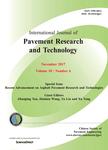版权所有:内蒙古大学图书馆 技术提供:维普资讯• 智图
内蒙古自治区呼和浩特市赛罕区大学西街235号 邮编: 010021

作者机构:Research Scientist II Pavements Team Virginia Transportation Research Council 530 Edgemont Rd. CharlottesvilleVA22903 United States Pavement Engineering and Science Program Department of Civil & Environmental Engineering University of Nevada RenoNV89557 United States
出 版 物:《International Journal of Pavement Research and Technology》 (Int. J. Pavement Res. Technol.)
年 卷 期:2020年第13卷第5期
页 面:510-523页
核心收录:
基 金:The contents of this paper reflect the views of the authors who are responsible for the facts and the accuracy of the data presented. The contents of this paper do not necessarily reflect the official views or policies of the sponsor at the time of publication. The authors thank Dr. Adam J. Hand at the University of Nevada Reno (UNR) for his help during the identification and procurement process of materials. Thanks are also due to Mr. Connor Overstreet Mr. Nicholas Peery Mr. Christian OQuinn Jr. at UNR for their work and assistance in the laboratory experiment. The author(s) declared no potential conflicts of interest with respect to the research authorship and/or publication of this article
主 题:Mixtures
摘 要:Reflective cracking is one of the major type of distresses associated with the use of asphalt concrete (AC) overlays for rehabilitating deteriorated asphalt pavements. The differential movements across the underlying cracks due to the combined effects of heavy wheel loads and temperature fluctuations result in physical tearing of the AC overlay. Thus, the long-term performance of AC overlays highly depends on their ability to resist reflective cracking. While conventional polymer-modified (PMA) AC mixtures with 2–3% polymer content have shown improved long-term performance when used as overlays, it is also believed that AC mixtures with higher polymer content may offer additional advantages for flexible rehabilitated pavements subjected to heavy and/or slow-moving traffic loads. This paper describes the research effort completed to evaluate the reflective cracking performance life of high polymer-modified (HP) AC mixtures used as overlays. Sixteen AC mixtures were produced in the laboratory using PMA and HP asphalt binders. These mixtures were evaluated in terms of their dynamic modulus and resistance to reflective cracking. The engineering properties and laboratory performance data were combined into a mechanistic analysis that took into consideration the existing AC pavement condition, mixture-specific material properties, traffic condition, and climate. Overall, the HP AC mixtures resulted in an increase in both time to reach initial cracking and reflective cracking performance life of the AC overlay when compared to their respective PMA AC overlay mixtures. © 2020, Chinese Society of Pavement Engineering.